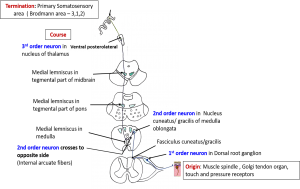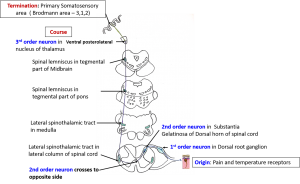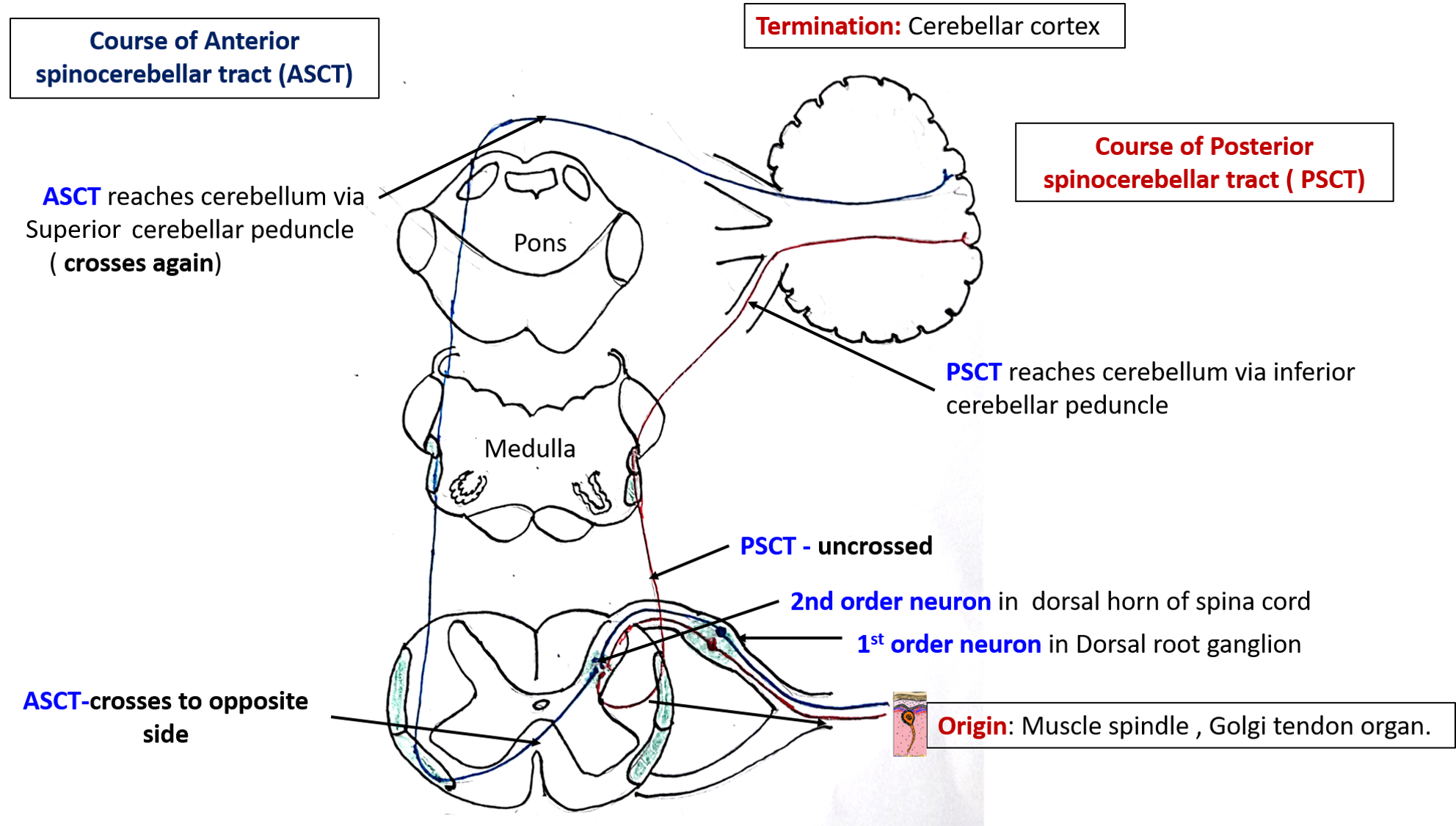What are tracts?
The tracts are the collection of axons (nerve fibers) in the central nervous system (CNS) that connect masses of grey matter. These nerve fibers have same origin, course, termination and function. Tracts are also referred as Fasciculi and Lemnisci. There are two types of tracts:
- Ascending tracts / sensory tracts – carry exteroceptive and proprioceptive sensations to higher centers of brain.
- Descending tracts / motor tracts – carry motor impulses from higher brain centers to motor nuclei of cranial nerves and anterior horn neurons of spinal cord.
What are the characteristic features of ascending tracts?
The characteristic features of ascending tracts are:
- The ascending tracts to cerebral cortex (posterior column tracts, spinothalamic tracts)
- involve a chain of 3 neurons ( 1st order, 2nd order and 3rd order neuron) to reach the cerebral cortex.
- originate from the exteroceptive and proprioceptive receptors.
- terminate mainly in the primary sensory cerebral cortex (Brodmann area number ( 3,1,2).
- has their 1st order neurons located outside the CNS, either in the dorsal root ganglion of spinal cord or sensory ganglion of cranial nerves ( exception is mesencephalic nucleus of trigeminal nerve, it contains 1st order sensory neurons for proprioception and is located in the midbrain).
- have their 2nd order neurons located in dorsal horn of spinal cord or medulla oblongata. It is the axon of 2nd order neuron that crosses to the opposite side (as the body is represented contralaterally in the cerebral cortex.
- have their 3rd order neuron located in the ventral posterior nucleus of thalamus.
- ascending tracts carry the sensory information from the body and external environment to the cerebral cortex that is used for conscious awareness of the various sensations as well as in figuring out the appropriate response to the stimuli.
- The ascending tracts to the cerebellum (spinocerebellar tracts)
- involve a chain of 2 neurons to reach the cerebellum
- originate from the proprioceptive receptors.
- terminate in the cerebellum.
- have their 1st order neurons located outside the CNS, in the dorsal root ganglion of spinal cord.
- have their 2nd order neurons located in dorsal horn of spinal cord or medulla oblongata.
- the representation of the body in the cerebellum is ipsilateral.
- carry the unconscious proprioception to the cerebellum which is used for postural control and coordination of movements.
Name the main ascending tracts and write the sensory modalities carried by them.
Ascending tract Sensations carried Spinothalamic tracts 1. Anterior spinothalamic Light touch & pressure,tickle, itch 2. Lateral spinothalamic Pain & temperature Posterior column tracts 1. Fasciculus gracilis 2. Fasciculius cuneatus Conscious proprioception, fine touch, tactile localization, two point discrimination, Spinocerebellar tracts 1. Anterior spinocerebellar Unconscious proprioception 2. Posterior spinocerebellar Unconscious proprioception
Draw labelled diagram to show the origin course and termination of ascending tracts.
Posterior Column Tract

Lateral SpinothalamicTract

Spinocerebellar Tracts

What are the characteristic features of descending tracts?
The characteristic features of descending tracts are:
- descending tracts involve 2 neurons ( upper and lower motor neurons).
- the motor neurons located in the anterior horn of spinal cord and motor nuclei of cranial nerves are referred to as lower motor neurons.
- the neurons present in the various parts of the brain which influence the activity of lower motor neurons are referred to as upper motor neurons.The control is usually contralateral.
- descending tracts arising from motor and premotor area of cerebral cortex constitute pyramidal tracts (lateral and anterior corticospinal tracts).
- all other descending tracts pathways having their origin in subcortical areas are referred to as extrapyramidal tracts (tectospinal, rubrospinal, reticulospinal, olivospinal and vestibulospinal).
Name the important descending tracts and write their functions.
Descending tract Function Corticospinal Tracts (Pyramidal Tract) Lateral and Anterior corticospinal tract Initiate and execute skilled voluntary movements. Extrapyramidal tracts Tectospinal tract Spinovisual reflexes (controls movement of head, neck in response to visual stimuli). Rubrospinal tract Facilitatory influence on flexor muscles and inhibitory influence on extensors. Vestibulospinal tract Postural reflexes (unconscious maintenance of posture and balance) Medial reticulospinal Facilitatory influence on extensor muscles. Lateral reticulospinal Facilitatory influence on flexor muscles.
Draw labelled diagram to show the origin, course and termination of corticospinal tracts.

What are the differences between upper motor neuron and lower motor neuron?
Features UMN LMN Paralysis Type Spastic Flaccid Muscle Tone Increased Decreased Muscle atrophy Absent Present Tendon reflexes Exaggerated Diminished Babinski’s sign Present Absent
Babinski’s sign
Dorsiflexion of great toe with fanning of lateral toes on scratching lateral aspect of plantar surface of foot. In healthy/normal adults the toes are planter flexed.

Amazing